A Molecularly Imprinted Membrane for High-Density Lipoprotein Extraction in Point-of-Care Testing
Abstract
1. Introduction
2. Materials and Methods
2.1. Chemical Reagents
2.2. Synthesis of MIP Nanoparticles and Nanoparticle Aggregates
2.3. Lipoprotein Depletion Experiments in Solution
2.4. Characterization of MIP Nanoparticles and Nanoparticle Aggregates
2.5. Preparation and Characterization of Molecularly Imprinted Membranes
2.6. Statistical Analysis
3. Results and Discussion
3.1. Synthesis of MIP Nanoparticles and Nanoparticle Aggregates
3.2. Characterization of the Properties of the MIP NPA
3.3. Integration of MIP NPAs in Paper Membranes and Characterization
- A sample deposition zone—Where the lipoprotein-containing sample was applied at the 17 mm position;
- An MIM zone—Located between 20 and 30 mm. The MIM zone contained ~0.28 mg of MIP NPAs deposited by dispensing drops of MIP NPA solution at the 25 mm mark. Assuming complete retention of the MIP NPAs during preparation (which remains unverified), this would correspond to an estimated density of ~47 mg/mL—approximately eight times higher than in the depletion experiment shown in Figure 3;
- A detection zone—Positioned downstream for monitoring unextracted lipoproteins.
3.4. Performance of the MIM for Solid-Phase Affinity Extraction of HDL
3.5. Elution Profile of LDL in the MIM-Containing Strips and Performance of the LDL-C Assay
4. Conclusions
Supplementary Materials
Author Contributions
Funding
Data Availability Statement
Conflicts of Interest
Abbreviations
| ABTS | 2,2′-Azino-bis(3-ethylbenzothiazoline-6-sulfonic acid) diammonium salt |
| APS | Ammonium persulfate |
| BSA | Bovine serum albumin fraction V |
| CE | Cholesterol esterase |
| CO | Cholesterol oxidase |
| DHEBA | N,N-(1,2-dihydroxyethylene)bisacrylamide |
| HDLs | High-density lipoproteins |
| HDL-C | High-density lipoprotein-cholesterol |
| HRP | Horseradish peroxidase |
| LDLs | Low-density lipoproteins |
| LDL-C | Low-density lipoprotein cholesterol |
| MAA | Methacrylic acid |
| MIM | Molecularly imprinted membrane |
| MIP | Molecularly imprinted polymer |
| NPAs | Nanoparticle aggregates |
| NIP | Non-imprinted polymer |
| PBS | Phosphate buffer saline |
| POC | Point of care |
| SPAE | Solid-phase affinity extraction |
| TEMED | N,N,N’,N’-tetramethylethylenediamine |
| VP | 1-vinyl-2-pyrrolidone |
References
- Kaptoge, S.; Pennells, L.; De Bacquer, D.; Cooney, M.T.; Kavousi, M.; Stevens, G.; Riley, L.M.; Savin, S.; Khan, T.; Altay, S.; et al. World Health Organization Cardiovascular Disease Risk Charts: Revised Models to Estimate Risk in 21 Global Regions. Lancet Glob. Health 2019, 7, e1332–e1345. [Google Scholar] [CrossRef]
- Mach, F.; Baigent, C.; Catapano, A.L.; Koskinas, K.C.; Casula, M.; Badimon, L.; Chapman, M.J.; De Backer, G.G.; Delgado, V.; Ference, B.A.; et al. 2019 ESC/EAS Guidelines for the Management of Dyslipidaemias: Lipid Modification to Reduce Cardiovascular Risk: The Task Force for the Management of Dyslipidaemias of the European Society of Cardiology (ESC) and European Atherosclerosis Society (EAS). Eur. Heart J. 2020, 41, 111–188. [Google Scholar] [CrossRef]
- Ahmadraji, T.; Killard, A.J. The Evolution of Selective Analyses of HDL and LDL Cholesterol in Clinical and Point of Care Testing. Anal. Methods 2013, 5, 3612–3625. [Google Scholar] [CrossRef]
- Bolodeoku, J.; Pinkney, S. Imprecision Evaluation of Self-Monitoring of Blood Cholesterol (SMBC)Handheld Point of Care Testing Devices: ElemarkTM and Cardiochek PA. Ann. Clin. Lab. Res. 2019, 7, 289. [Google Scholar]
- Wang, X.; Hu, L. Review—Enzymatic Strips for Detection of Serum Total Cholesterol with Point-of-Care Testing (POCT) Devices: Current Status and Future Prospect. J. Electrochem. Soc. 2020, 167, 037535. [Google Scholar] [CrossRef]
- Anaokar, S.G.; Crispino, M.J.; Crabtree, E.P. Method for Determining Concentration of Multiple Analytes in a Single Fluid Sample. U.S. Patent 7494818 B1, 24 February 2009. [Google Scholar]
- Parween, S.; Subudhi, P.D.; Asthana, A. An Affordable, Rapid Determination of Total Lipid Profile Using Paper-Based Microfluidic Device. Sens. Actuators B Chem. 2019, 285, 405–412. [Google Scholar] [CrossRef]
- Lawrence, G.M.; Pasqua, J. Direct Measurement of Chlolesterol from Low Density Lipoprotein with Test Strip. U.S. Patent 7435577 B2, 14 October 2008. [Google Scholar]
- Oncescu, V.; Mancuso, M.; Erickson, D. Cholesterol Testing on a Smartphone. Lab Chip 2014, 14, 759–763. [Google Scholar] [CrossRef]
- BelBruno, J.J. Molecularly Imprinted Polymers. Chem. Rev. 2019, 119, 94–119. [Google Scholar] [CrossRef] [PubMed]
- Saylan, Y.; Akgönüllü, S.; Yavuz, H.; Ünal, S.; Denizli, A. Molecularly Imprinted Polymer Based Sensors for Medical Applications. Sensors 2019, 19, 1279. [Google Scholar] [CrossRef] [PubMed]
- Göktürk, I.; Güler, K.Ç.; Yılmaz, F.; Oktar, C.; Yılmaz, G.E.; Denizli, A. Molecularly Imprinted Polymeric Biomaterials in Diagnosis and Medical Practice. Biomed. Mater. Devices 2025, 3, 299–316. [Google Scholar] [CrossRef]
- Chunta, S.; Suedee, R.; Lieberzeit, P.A. High-Density Lipoprotein Sensor Based on Molecularly Imprinted Polymer. Anal. Bioanal. Chem. 2018, 410, 875–883. [Google Scholar] [CrossRef]
- Chunta, S.; Suedee, R.; Lieberzeit, P.A. Low-Density Lipoprotein Sensor Based on Molecularly Imprinted Polymer. Anal. Chem. 2016, 88, 1419–1425. [Google Scholar] [CrossRef] [PubMed]
- Chunta, S.; Suedee, R.; Singsanan, S.; Lieberzeit, P.A. Sensing Array Based on Molecularly Imprinted Polymers for Simultaneous Assessment of Lipoproteins. Sens. Actuators B Chem. 2019, 298, 126828. [Google Scholar] [CrossRef]
- Chunta, S.; Boonsriwong, W.; Wattanasin, P.; Naklua, W.; Lieberzeit, P.A. Direct Assessment of Very-Low-Density Lipoprotein by Mass Sensitive Sensor with Molecularly Imprinted Polymers. Talanta 2021, 221, 121549. [Google Scholar] [CrossRef]
- Li, W.; Zhang, X.; Li, T.; Ji, Y.; Li, R. Molecularly Imprinted Polymer-Enhanced Biomimetic Paper-Based Analytical Devices: A Review. Anal. Chim. Acta 2021, 1148, 238196. [Google Scholar] [CrossRef]
- Alahmad, W.; Cetinkaya, A.; Kaya, S.I.; Varanusupakul, P.; Ozkan, S.A. Molecularly Imprinted Polymer Paper-Based Analytical Devices for Biomarkers Detection. TrAC Trends Anal. Chem. 2024, 170, 117475. [Google Scholar] [CrossRef]
- Zarejousheghani, M.; Schrader, S.; Möder, M.; Schmidt, M.; Borsdorf, H. A New Strategy for Accelerated Extraction of Target Compounds Using Molecularly Imprinted Polymer Particles Embedded in a Paper-Based Disk. J. Mol. Recognit. 2018, 31, e2629. [Google Scholar] [CrossRef]
- Yang, H.; Liu, H.-B.; Tang, Z.-S.; Qiu, Z.-D.; Zhu, H.-X.; Song, Z.-X.; Jia, A.-L. Synthesis, Performance, and Application of Molecularly Imprinted Membranes: A Review. J. Environ. Chem. Eng. 2021, 9, 106352. [Google Scholar] [CrossRef]
- Ratnaningsih, E.; Kadja, G.T.M.; Putri, R.M.; Alni, A.; Khoiruddin, K.; Djunaidi, M.C.; Ismadji, S.; Wenten, I.G. Molecularly Imprinted Affinity Membrane: A Review. ACS Omega 2022, 7, 23009–23026. [Google Scholar] [CrossRef] [PubMed]
- Torres-Cartas, S.; Catalá-Icardo, M.; Meseguer-Lloret, S.; Simó-Alfonso, E.F.; Herrero-Martínez, J.M. Recent Advances in Molecularly Imprinted Membranes for Sample Treatment and Separation. Separations 2020, 7, 69. [Google Scholar] [CrossRef]
- Boontongto, T.; Santaladchaiyakit, Y.; Burakham, R. Molecularly Imprinted Polymer-Coated Paper for the Selective Extraction of Organophosphorus Pesticides from Fruits, Vegetables, and Cereal Grains. Talanta 2024, 270, 125536. [Google Scholar] [CrossRef]
- Wu, Y.; Xing, W.; Yan, J.; Cui, J.; Ma, F.; Gao, J.; Lu, J.; Yu, C.; Yan, M. Multilevel Mineral-Coated Imprinted Nanocomposite Membranes for Template-Dependent Recognition and Separation: A Well-Designed Strategy with PDA/CaCO3-Based Loading Structure. J. Colloid Interface Sci. 2020, 575, 356–366. [Google Scholar] [CrossRef]
- Xie, W.; Wang, H.; Tong, Y.W.; Sankarakumar, N.; Yin, M.; Wu, D.; Duan, X. Specific Purification of a Single Protein from a Cell Broth Mixture Using Molecularly Imprinted Membranes for the Biopharmaceutical Industry. RSC Adv. 2019, 9, 23425–23434. [Google Scholar] [CrossRef] [PubMed]
- Wu, X.; Wang, Y.; Qin, B.; Shao, G.; Wang, Z.; Wang, T.; Fu, Y. A Nanocellulose Molecularly Imprinted Membrane: Preparation, Characterization and Application in Targeted Separation of Taxane 10-Deacetylbaccatin III. Int. J. Biol. Macromol. 2023, 253, 126794. [Google Scholar] [CrossRef]
- Climent, E.; Wan, W.; Rurack, K. Toward Label-Free Optical Multiplexing of Analytes in Indicator Release Lateral Flow Assays via Detection Zones Containing Tailored Capture Materials. Anal. Sens. 2022, 2, e202100062. [Google Scholar] [CrossRef]
- He, Y.; Hong, S.; Wang, M.; Wang, J.; El-Aty, A.M.A.; Wang, J.; Hacimuftuoglu, A.; Khan, M.; She, Y. Development of Fluorescent Lateral Flow Test Strips Based on an Electrospun Molecularly Imprinted Membrane for Detection of Triazophos Residues in Tap Water. New J. Chem. 2020, 44, 6026–6036. [Google Scholar] [CrossRef]
- Zhang, H.; Li, Y.; Zheng, D.; Cao, S.; Chen, L.; Huang, L.; Xiao, H. Bio-Inspired Construction of Cellulose-Based Molecular Imprinting Membrane with Selective Recognition Surface for Paclitaxel Separation. Appl. Surf. Sci. 2019, 466, 244–253. [Google Scholar] [CrossRef]
- Malmsten, M.; Siegel, G.; Wood, W.G. Ellipsometry Studies of Lipoprotein Adsorption. J. Colloid Interface Sci. 2000, 224, 338–346. [Google Scholar] [CrossRef]
- Gunkel, G.; Huck, W.T.S. Cooperative Adsorption of Lipoprotein Phospholipids, Triglycerides, and Cholesteryl Esters Are a Key Factor in Nonspecific Adsorption from Blood Plasma to Antifouling Polymer Surfaces. J. Am. Chem. Soc. 2013, 135, 7047–7052. [Google Scholar] [CrossRef]
- Behm, E.; Loth, F.; Toewe, D.; Zschörnig, O.; Ernst, B.; Klinkmann, H. Low Density Lipoprotein Binding by Macroporous Bead Cellulose. Biomed. Biochim. Acta 1989, 48, 829–837. [Google Scholar]
- Tian, Y.; Kong, Y.; Liu, X.; Chen, L.; Wang, L.; Zhou, L.; Wang, G.; Zhang, Q. Regenerated Carboxymethyl Cellulose Beads for Selective Removal of Low-Density Lipoprotein from Whole Blood. Carbohydr. Polym. 2025, 348, 122848. [Google Scholar] [CrossRef] [PubMed]


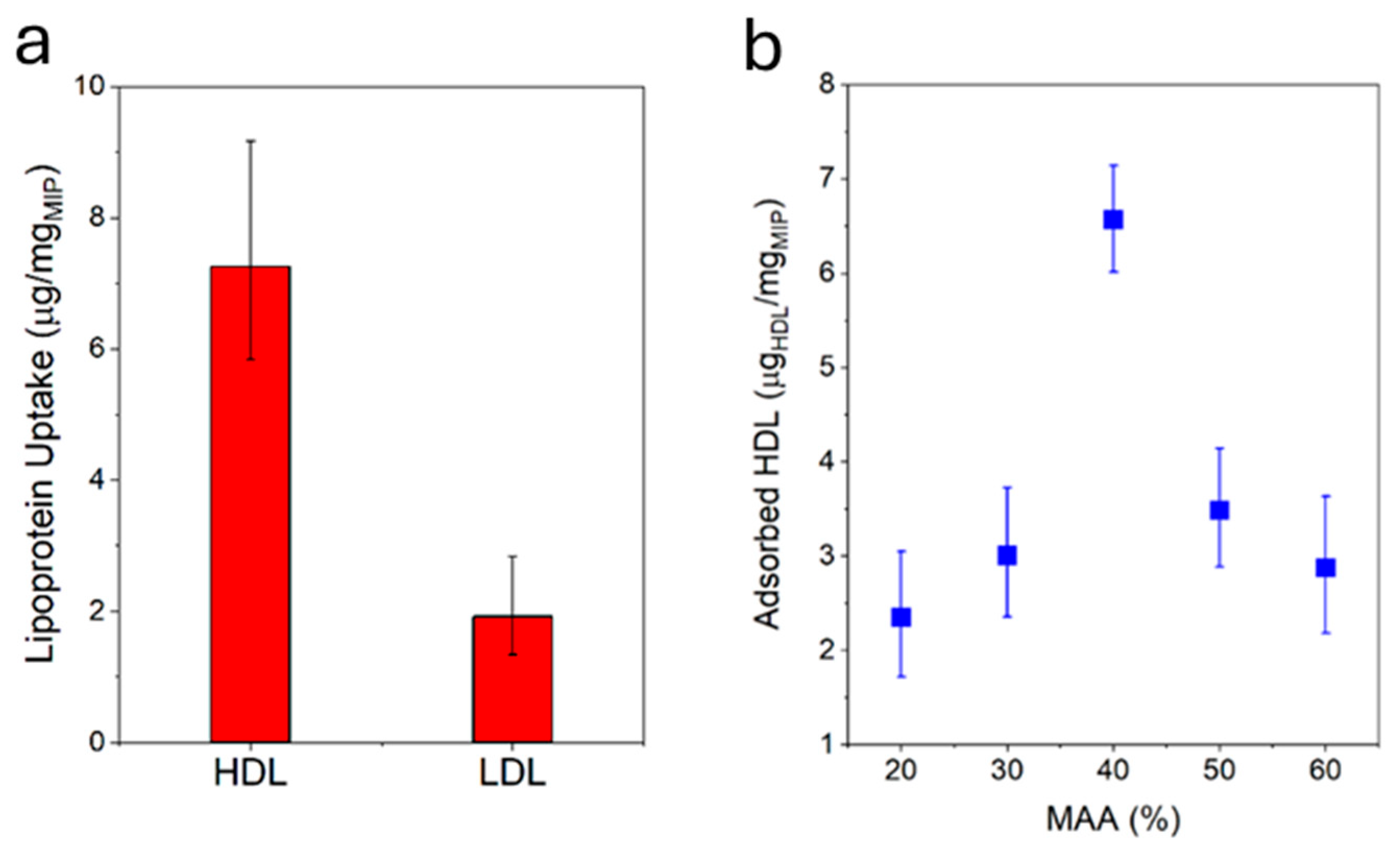
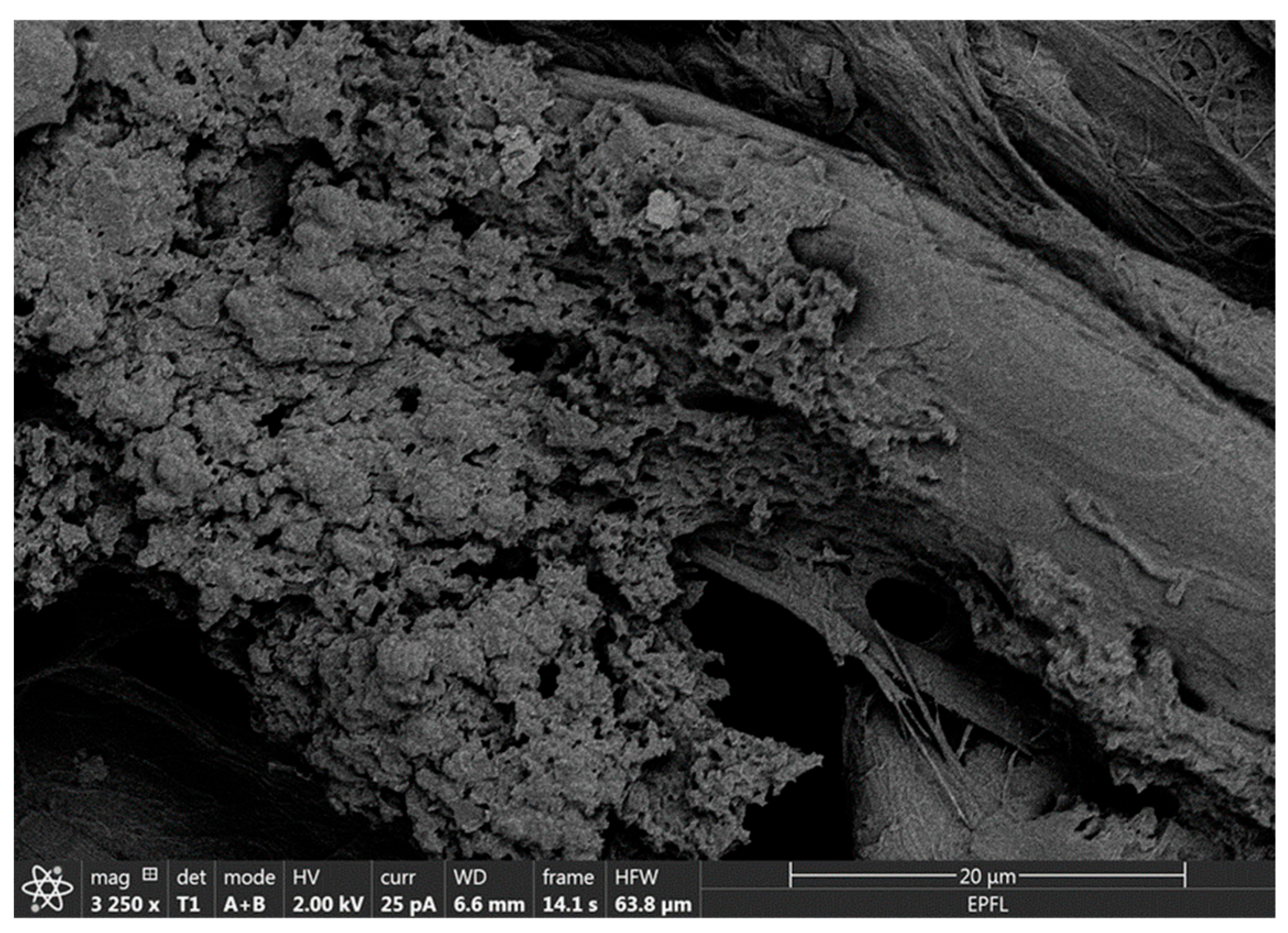
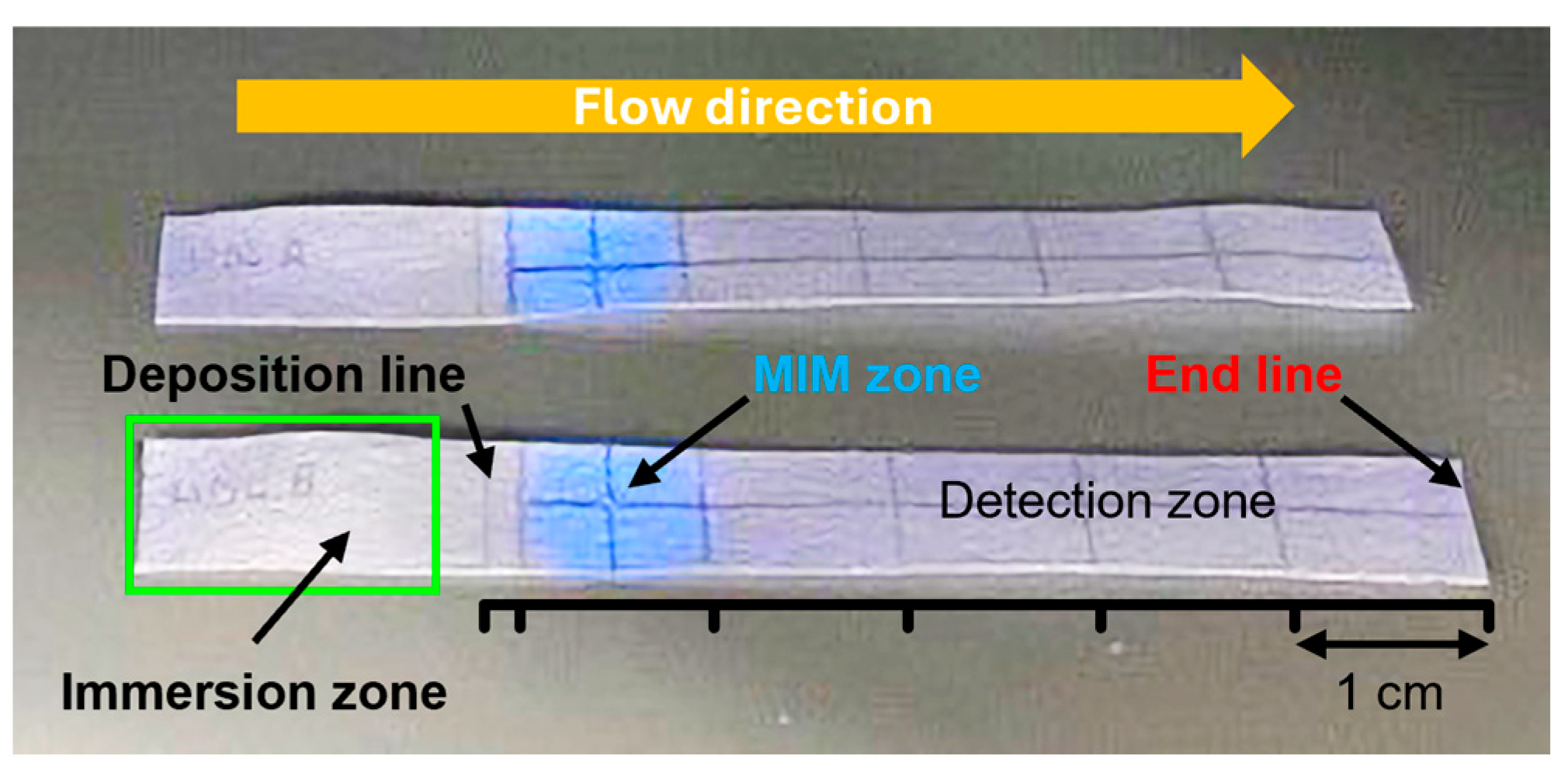
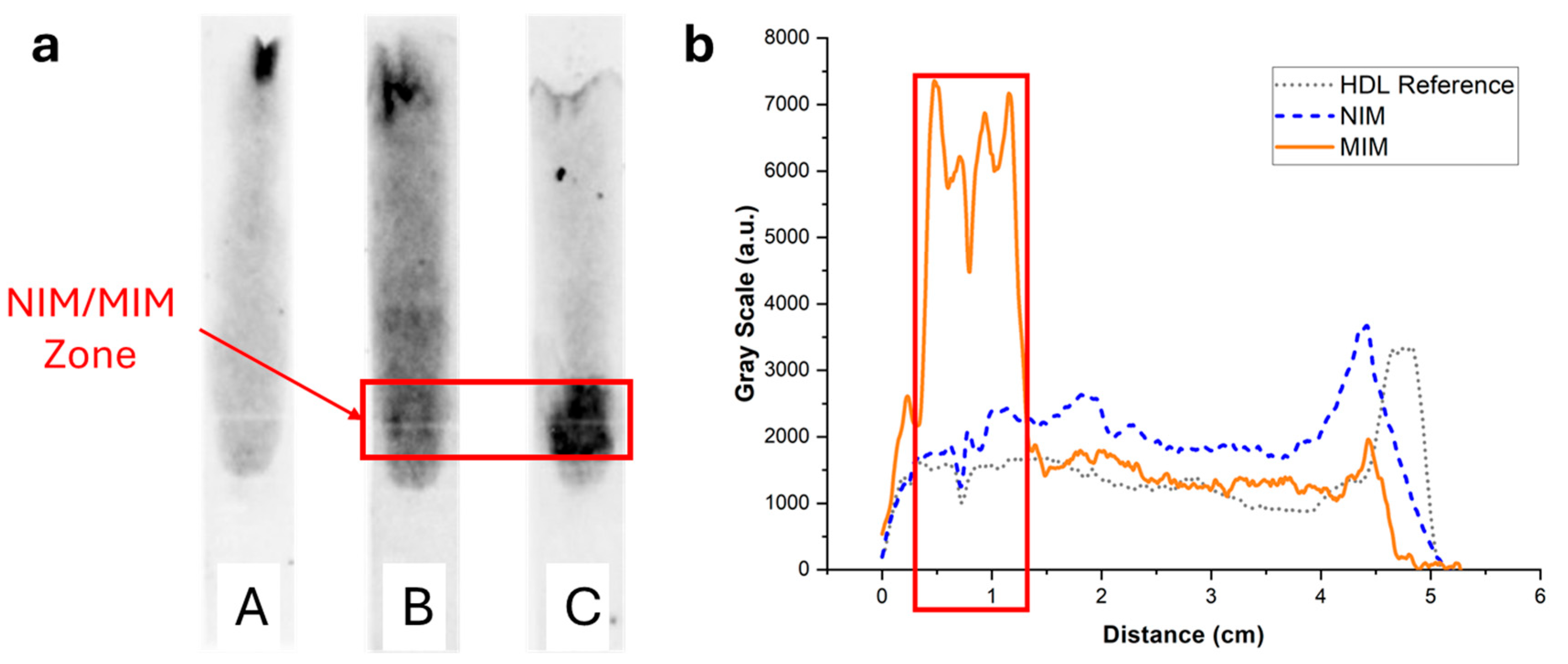
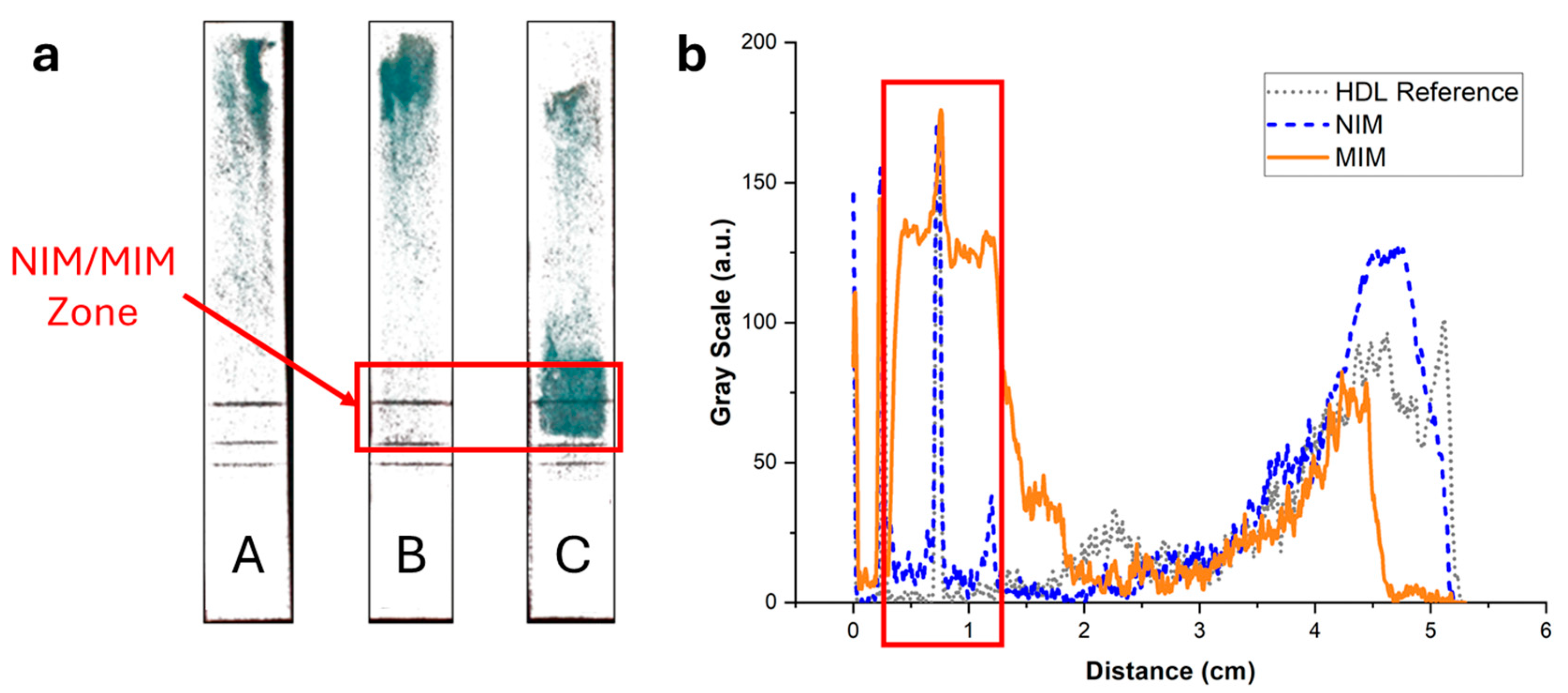
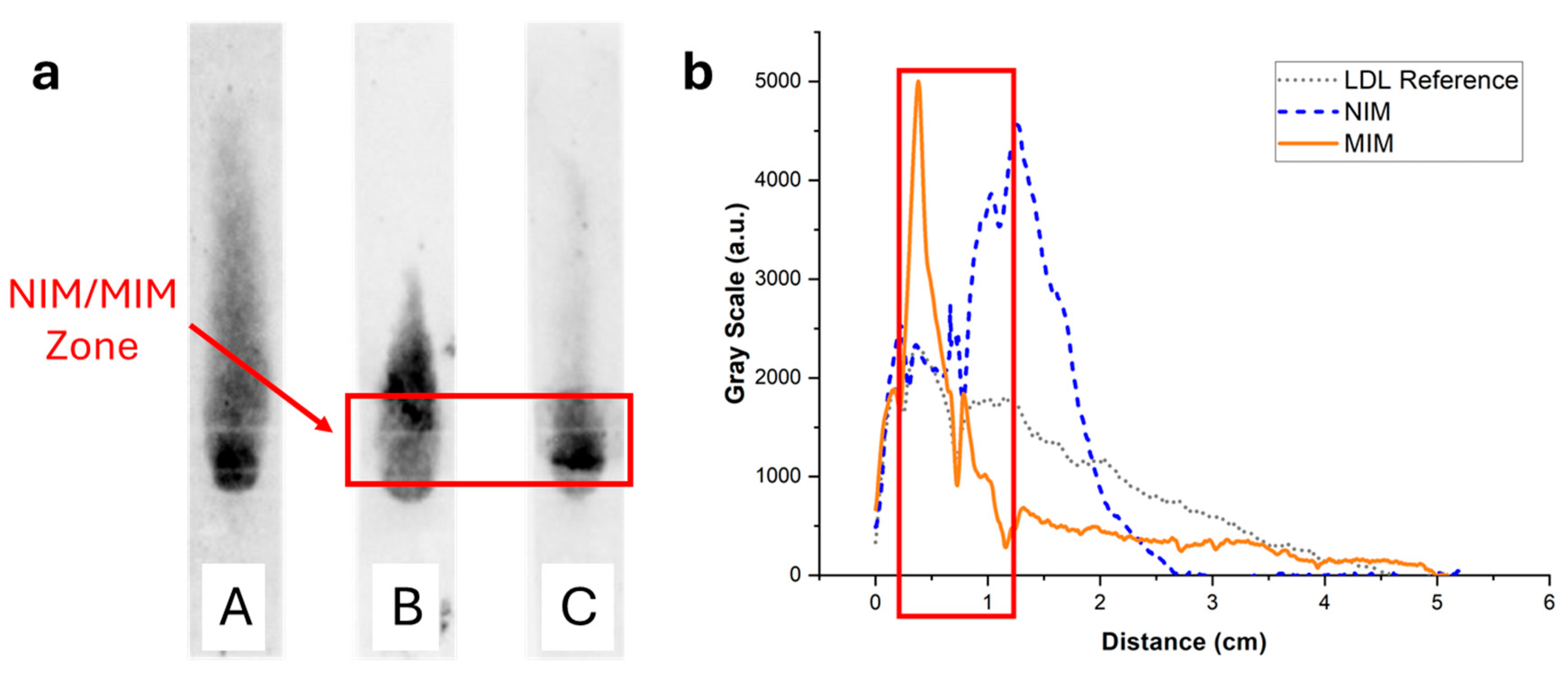
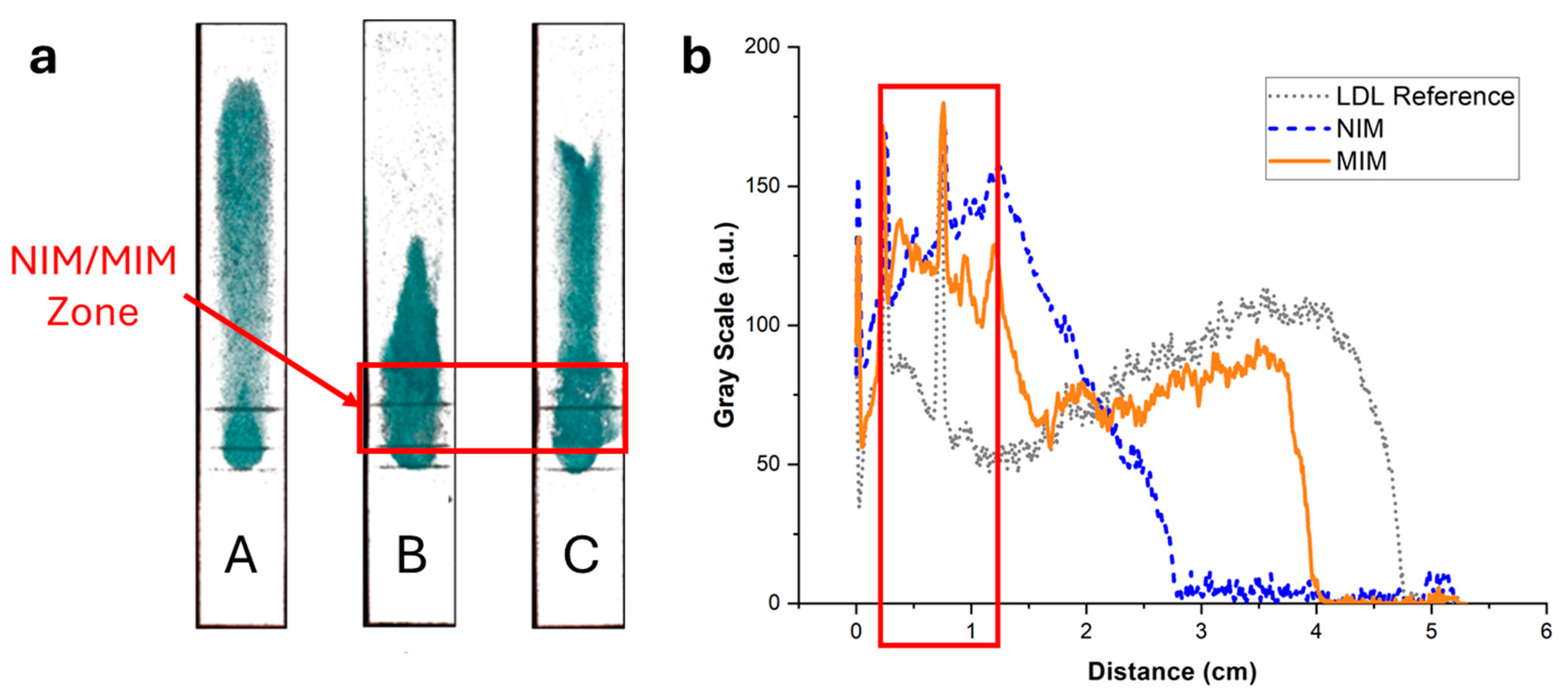
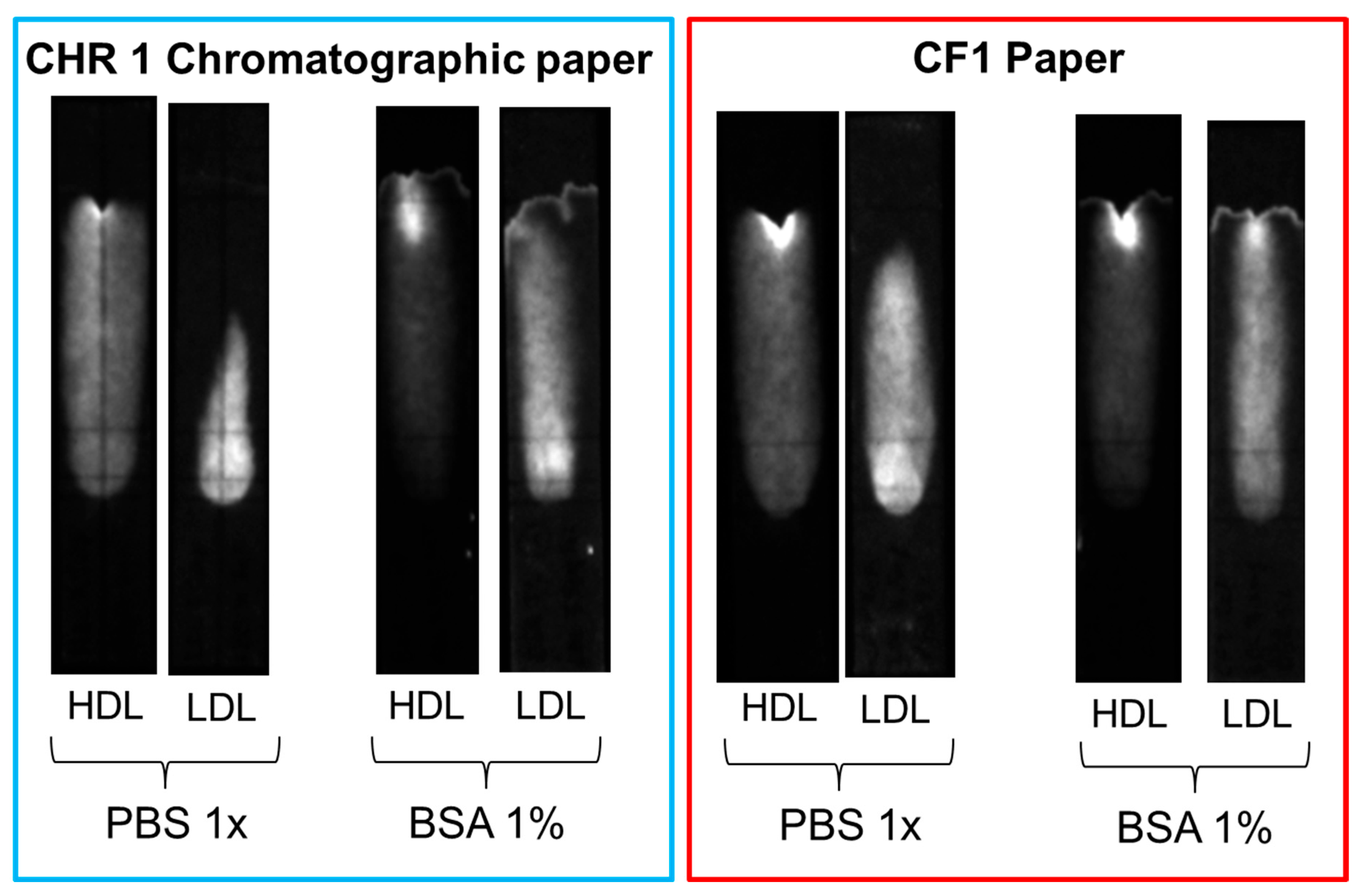
Disclaimer/Publisher’s Note: The statements, opinions and data contained in all publications are solely those of the individual author(s) and contributor(s) and not of MDPI and/or the editor(s). MDPI and/or the editor(s) disclaim responsibility for any injury to people or property resulting from any ideas, methods, instructions or products referred to in the content. |
© 2025 by the authors. Licensee MDPI, Basel, Switzerland. This article is an open access article distributed under the terms and conditions of the Creative Commons Attribution (CC BY) license (https://creativecommons.org/licenses/by/4.0/).
Share and Cite
de Gregorio, G.L.; Prim, D.; Zavattoni, A.; Mottini, I.; Pezzoli, D.; Roveda, F.; Pfeifer, M.E.; Segura, J.-M. A Molecularly Imprinted Membrane for High-Density Lipoprotein Extraction in Point-of-Care Testing. Biosensors 2025, 15, 685. https://doi.org/10.3390/bios15100685
de Gregorio GL, Prim D, Zavattoni A, Mottini I, Pezzoli D, Roveda F, Pfeifer ME, Segura J-M. A Molecularly Imprinted Membrane for High-Density Lipoprotein Extraction in Point-of-Care Testing. Biosensors. 2025; 15(10):685. https://doi.org/10.3390/bios15100685
Chicago/Turabian Stylede Gregorio, Gian Luca, Denis Prim, Alberto Zavattoni, Italo Mottini, Daniele Pezzoli, Federico Roveda, Marc E. Pfeifer, and Jean-Manuel Segura. 2025. "A Molecularly Imprinted Membrane for High-Density Lipoprotein Extraction in Point-of-Care Testing" Biosensors 15, no. 10: 685. https://doi.org/10.3390/bios15100685
APA Stylede Gregorio, G. L., Prim, D., Zavattoni, A., Mottini, I., Pezzoli, D., Roveda, F., Pfeifer, M. E., & Segura, J.-M. (2025). A Molecularly Imprinted Membrane for High-Density Lipoprotein Extraction in Point-of-Care Testing. Biosensors, 15(10), 685. https://doi.org/10.3390/bios15100685






